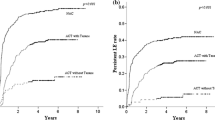Abstract
Neoadjuvant chemotherapy has been increasingly used to downstage breast cancer prior to surgery recently. However, in some cases, it was observed that despite sufficient regression of primary tumors, the metastatic lymph nodes remained nonresponsive. In this study, we applied lymphatic-targeted strategy to evaluate its efficacy and safety for patients presenting refractory nodes following systemic chemotherapy. A total of 318 breast cancer patients were demonstrated with lymph node metastasis by needle biopsy and given neoadjuvant chemotherapy. Two cycles later, 72 patients were observed with responsive tumors but stable nodes, 42 of which received a subcutaneous injection of lymphatic-targeted pegylated liposomal doxorubicin during the third cycle, while the remaining 30 patients were continued with former neoadjuvant therapeutic pattern and regarded as the control. Lymphatic-targeted treatment substantially increased both clinical and pathological node response rate [62 % (26/42) vs. 13 % (4/30) and 12 % (5/42) vs. 0 (0/30), respectively], and induced a higher apoptosis level of metastatic cells (median, 41 vs. 6 %), compared with the control. Moreover, a higher disease-free survival was observed after a median follow-up of 4 years (69 vs. 56 %). Inflammatory reaction surrounding injection sites was the most common side effect. Lymphatic chemotherapy has reliable efficacy and well-tolerated toxicity for breast cancer patients presenting refractory lymph nodes following neoadjuvant chemotherapy.




Similar content being viewed by others
References
Sleeman JP. The lymph node as a bridgehead in the metastatic dissemination of tumors. Recent Results Cancer Res Fortschritte der Krebsforschung Progres dans les recherches sur le cancer. 2000;157:55–81.
Voordeckers M, Vinh-Hung V, Van de Steene J, Lamote J, Storme G. The lymph node ratio as prognostic factor in node-positive breast cancer. Radiother Oncol. 2004;70:225–30.
Weigelt B, Glas AM, Wessels LF, Witteveen AT, Peterse JL, Van’t Veer LJ. Gene expression profiles of primary breast tumors maintained in distant metastases. Proc Natl Acad Sci USA. 2003;100:15901–5.
Nishioka Y, Yoshino H. Lymphatic targeting with nanoparticulate system. Adv Drug Deliv Rev. 2001;47:55–64.
Eccles S, Paon L, Sleeman J. Lymphatic metastasis in breast cancer: importance and new insights into cellular and molecular mechanisms. Clin Exp Metastasis. 2007;24:619–36.
Jansen L, Doting MH, Rutgers EJ, de Vries J, Olmos RA, Nieweg OE. Clinical relevance of sentinel lymph nodes outside the axilla in patients with breast cancer. Br J Surg. 2000;87:920–5.
Oussoren C, Storm G. Liposomes to target the lymphatics by subcutaneous administration. Adv Drug Deliv Rev. 2001;50:143–56.
Chen JH, Ling R, Yao Q, Li Y, Chen T, Wang Z, et al. Effect of small-sized liposomal Adriamycin administered by various routes on a metastatic breast cancer model. Endocr Relat Cancer. 2005;12:93–100.
Chen J, Wang L, Yao Q, Ling R, Li K, Wang H. Drug concentrations in axillary lymph nodes after lymphatic chemotherapy on patients with breast cancer. Breast Cancer Res. 2004;6:R474–7.
Herrada J, Iyer RB, Atkinson EN, Sneige N, Buzdar AU, Hortobagyi GN. Relative value of physical examination, mammography, and breast sonography in evaluating the size of the primary tumor and regional lymph node metastases in women receiving neoadjuvant chemotherapy for locally advanced breast carcinoma. Clin Cancer Res. 1997;3:1565–9.
Miller AB, Hoogstraten B, Staquet M, Winkler A. Reporting results of cancer treatment. Cancer. 1981;47:207–14.
Kurosumi M. Significance and problems in evaluations of pathological responses to neoadjuvant therapy for breast cancer. Breast Cancer (Tokyo, Japan). 2006;13:254–9.
Gusterson BA, Gelber RD, Goldhirsch A, Price KN, Save-Soderborgh J, Anbazhagan R, et al. Prognostic importance of c-erbB-2 expression in breast cancer. International (Ludwig) Breast Cancer Study Group. J Clin Oncol. 1992;10:1049–56.
Jotti GS, Johnston SR, Salter J, Detre S, Dowsett M. Comparison of new immunohistochemical assay for oestrogen receptor in paraffin wax embedded breast carcinoma tissue with quantitative enzyme immunoassay. J Clin Pathol. 1994;47:900–5.
Powles TJ, Hickish TF, Makris A, Ashley SE, O’Brien ME, Tidy VA, et al. Randomized trial of chemoendocrine therapy started before or after surgery for treatment of primary breast cancer. J Clin Oncol. 1995;13:547–52.
Smith IE, Walsh G, Jones A, Prendiville J, Johnston S, Gusterson B, et al. High complete remission rates with primary neoadjuvant infusional chemotherapy for large early breast cancer. J Clin Oncol. 1995;13:424–9.
Fisher B, Bryant J, Wolmark N, Mamounas E, Brown A, Fisher ER, et al. Effect of preoperative chemotherapy on the outcome of women with operable breast cancer. J Clin Oncol. 1998;16:2672–85.
Smith IE, Lipton L. Preoperative/neoadjuvant medical therapy for early breast cancer. Lancet Oncol. 2001;2:561–70.
Blades MC, Manzo A, Ingegnoli F, Taylor PR, Panayi GS, Irjala H, et al. Stromal cell-derived factor 1 (CXCL12) induces human cell migration into human lymph nodes transplanted into SCID mice. Journal of Immunology (Baltimore, Md: 1950). 2002;168:4308–17.
Sallusto F, Palermo B, Lenig D, Miettinen M, Matikainen S, Julkunen I, et al. Distinct patterns and kinetics of chemokine production regulate dendritic cell function. Eur J Immunol. 1999;29:1617–25.
Randolph GJ, Angeli V, Swartz MA. Dendritic-cell trafficking to lymph nodes through lymphatic vessels. Nat Rev Immunol. 2005;5:617–28.
Bachmann MF, Kopf M, Marsland BJ. Chemokines: more than just road signs. Nat Rev Immunol. 2006;6:159–64.
Zamboni WC. Concept and clinical evaluation of carrier-mediated anticancer agents. Oncologist. 2008;13:248–60.
Al-Batran SE, Bischoff J, von Minckwitz G, Atmaca A, Kleeberg U, Meuthen I, et al. The clinical benefit of pegylated liposomal doxorubicin in patients with metastatic breast cancer previously treated with conventional anthracyclines: a multicentre phase II trial. Br J Cancer. 2006;94:1615–20.
Acknowledgments
This work was supported by Grants provided by National Natural Science Foundation of China (No. 81172510, JC; No. 81272899, LW) and Natural Science Foundation of Shaanxi Province (No. 2011K12-45, JC; No. 2012K13-02-28, QY).
Conflict of interest
The authors declare that they have no conflict of interest.
Author information
Authors and Affiliations
Corresponding authors
Additional information
Jianghao Chen and Qing Yao have contributed equally to this work.
Rights and permissions
About this article
Cite this article
Chen, J., Yao, Q., Wang, H. et al. Lymphatic-targeted therapy following neoadjuvant chemotherapy: a promising strategy for lymph node-positive breast cancer treatment. Med Oncol 32, 184 (2015). https://doi.org/10.1007/s12032-015-0634-7
Received:
Accepted:
Published:
DOI: https://doi.org/10.1007/s12032-015-0634-7




